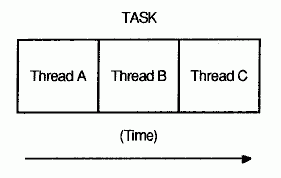
In the pipelining model, a task is divided into steps. The steps must be performed in sequence to produce a single instance of the desired output, and the work done in each step (except for the first and last) is based on the preceding step and is a prerequisite for the work in the next step. However, the program is designed to produce multiple instances of the desired output, and the steps are designed to operate in a parallel time frame so that each step is kept busy.
An example of the pipelining model is an automobile assembly line. Each step or stage in the assembly line is continually busy receiving the product of the previous stage's work, performing its assigned work, and passing the product along to the next stage. A car needs a body before it can be painted, but at any one time numerous cars are receiving bodies, and then numerous cars are being painted.
In a multithreaded program using the pipelining model, each thread represents a step in the task. The following figure shows a task performed by three threads in a pipelining model.
Pipelining Model
